Enhancing NUE in Corn Through Optimized Sensor-Based Prescription Maps
Abstract
1. Introduction
2. Material and Methods
2.1. Study Area
2.2. Experimental Design
2.3. Soil Sampling and Analysis
2.4. Gathering Data by Sensors
2.5. Yield Sampling and Map
2.6. Nitrogen Use Efficiently (NUE)
2.7. Statistical Analysis
3. Results
3.1. Soil Features Results
3.2. Performance of Different Developed Nitrogen Application Methods
3.2.1. Corn Yield Under Different Nitrogen Application Methods
3.2.2. NUE Under Different Nitrogen Application Methods
3.3. Comparison of Flat-Rate- and Remote-Sensing-Based Nitrogen Application Methods
3.4. Analysis of Yield Map
4. Discussion
5. Conclusions
Author Contributions
Funding
Institutional Review Board Statement
Informed Consent Statement
Data Availability Statement
Acknowledgments
Conflicts of Interest
References
- Zhang, X.; Davidson, E.A.; Mauzerall, D.L.; Searchinge, T.D.; Dumas, P.; Shen, Y. Managing nitrogen for sustainable development. Nature 2015, 528, 51–59. [Google Scholar] [CrossRef] [PubMed]
- Food and Agriculture Organization of the United Nations (FAO). World Fertilizer Trends and Outlook to 2022; FAO: Rome, Italy, 2020. [Google Scholar]
- USDA. United States Department of Agriculture Foreign Agricultural Service Circular Series WAP. 2022. Available online: https://apps.fas.usda.gov/psdonline/circulars/production.pdf (accessed on 5 May 2022).
- Raza, S.; Farmaha, B.S. Contrasting corn yield responses to nitrogen fertilization in southeast coastal plain soils. Front. Environ. Sci. 2022, 10, 955142. [Google Scholar] [CrossRef]
- Tester, M.; Langridge, P. Breeding technologies to increase crop production in a changing world. Science 2010, 327, 818–822. [Google Scholar] [CrossRef] [PubMed]
- Omara, P.; Aula, L.; Oyebiyi, F.; Raun, W.R. World cereal nitrogen use efficiency trends: Review and current knowledge. Agrosyst. Geosci. Environ. 2019, 2, 1–8. [Google Scholar] [CrossRef]
- Abdalla, A.; Mirzakhani Nafchi, A. Development and Evaluation of an Affordable Variable Rate Applicator Controller for Precision Agriculture. AgriEngineering 2024, 6, 4639–4657. [Google Scholar] [CrossRef]
- Kahrl, F.; Li, Y.; Su, Y.; Tennigkeit, T.; Wilkes, A.; Xu, J. Greenhouse gas emissions from nitrogen fertilizer use in China. Environ. Sci. Policy 2010, 13, 688–694. [Google Scholar] [CrossRef]
- Billen, G.; Beusen, A.; Bouwman, L.; Garnier, J. Anthropogenic nitrogen autotrophy and heterotrophy of the world’s watersheds: Past, present, and future trends. Glob. Biogeochem. Cycles 2010, 24, 12. [Google Scholar] [CrossRef]
- Raza, S.; Zamanian, K.; Ullah, S.; Kuzyakov, Y.; Virto, I.; Zhou, J. Inorganic carbon losses by soil acidification jeopardize global efforts on carbon sequestration and climate change mitigation. J. Clean. Prod. 2021, 315, 128036. [Google Scholar] [CrossRef]
- Xiong, Q.; Tang, G.; Zhong, L.; He, H.; Chen, X. Response to nitrogen deficiency and compensation on physiological characteristics, yield formation, and nitrogen utilization of rice. Front. Plant Sci. 2018, 9, 1075. [Google Scholar] [CrossRef]
- Govindasamy, P.; Muthusamy, S.K.; Bagavathiannan, M.; Mowrer, J.; Jagannadham, P.T.K.; Maity, A.; Halli, H.M.; Vadivel, R.T.K.D.; Raj, R.; Pooniya, V.; et al. Nitrogen use efficiency—A key to enhance crop productivity under a changing climate. Front. Plant Sci. 2023, 14, 1121073. [Google Scholar] [CrossRef]
- Mirzaee, S.; Mirzakhani Nafchi, A. Advancing Global Nitrogen Use Efficiency for Environmental Sustainability. In Land Degradation and Development; Wiley: New York, NY, USA, 2025; pp. 1–12. [Google Scholar]
- Koch, B.; Khosla, R.; Frasier, W.M.; Westfall, D.G.; Inman, D. Economic Feasibility of Variable-Rate Nitrogen Application Utilizing Site-Speicific Management Zones. Agron. J. 2004, 96, 1572–1580. [Google Scholar] [CrossRef]
- Guerrero, A.; De Neve, S.; Mouazen, A.M. Data fusion approach for map-based variable-rate nitrogen fertilization in barley and wheat. Soil Tillage Res. 2021, 205, 104789. [Google Scholar] [CrossRef]
- McFadden, J.; Njuki, E.; Griffin, T. Precision Agriculture in the Digital Era: Recent Adoption on U.S. Farms, EIB-248; U.S. Department of Agriculture, Economic Research Service: Washington, DC, USA, 2023.
- Lambert, D.M.; Lowenberg-DeBoer, J.; Malzer, G.L. Economic analysis of spatial–temporal patterns in corn and soybean response to nitrogen and phosphorus, Agron. J. 2006, 98, 43–54. [Google Scholar]
- Wang, T.; Jin, H.; Sieverding, H.; Kumar, S.; Miao, Y.; Rao, X.; Obembe, O.; Mirzakhani Nafchi, A.; Redfearn, D.; Cheye, S. Understanding farmer views of precision agriculture profitability in the US Midwest. Ecol. Econ. 2023, 213, 107950. [Google Scholar] [CrossRef]
- Robertson, G.P.; Groffman, P.M. Nitrogen transformations. In Soil Microbiology, Ecology, and Biochemistry; Paul, E.A., Ed.; Academic Press: Burlington, NJ, USA, 2007; pp. 341–364. [Google Scholar]
- Raun, W.R.; Dhillon, J.; Aula, L.; Eickhof, E.; Weymeyer, G.; Figueirdeo, B.; Lynch, T.; Omara, P.; Nambi, E.; Oyebiyi, F.; et al. Unpredictable nature of environment on nitrogen supply and demand. Agron. J. 2019, 111, 2786–2791. [Google Scholar] [CrossRef]
- Ali, A.M.; Ibrahim, S.M.; Salem, E.M.M.; El Sadek, A.N.; Salem, H.M. In-Season Estimation of Wheat Response to Nitrogen Using Normalized Difference Vegetation Index. Int. J. Plant Prod. 2022, 16, 681–689. [Google Scholar] [CrossRef]
- Mirzaee, S.; Mirzakhani Nafchi, A. Pros and Cons of Yield Goal-Based Variable Rate Nitrogen Prescription Maps. In Proceedings of the 2024 SABE Annual International Meeting, Anaheim, CA, USA, 28–31 July 2024. [Google Scholar]
- Lory, J.A.; Scharf, P.C. Yield goal versus delta yield for predicting fertilizer nitrogen need in corn. Agron. J. 2003, 95, 994–999. [Google Scholar] [CrossRef]
- Clark, J. Fertilizer Recommendation Guide. SDSU Extension. 2023. Available online: https://extension.sdstate.edu/fertilizer-recommendation-guide (accessed on 5 May 2022).
- Gee, G.W.; Bauder, J.W. Particle size analysis. In Methods of Soil Analysis: Part 1 Agronomy Handbook No 9; Klute, A., Ed.; American Society of Agronomy and Soil Science Society of America: Madison, WI, USA, 1986; pp. 383–411. [Google Scholar]
- Watson, M.E.; Brown, J.R. pH and lime requirement. In Recommended Chemical Soil Test Procedures for the North Central Region; Brown, J.R., Ed.; North Central Regional Publication No. 221 (Revised); University of Missouri Agricultural Experiment Station: Columbia, MO, USA, 1998; pp. 13–16. [Google Scholar]
- U.S. Salinity Laboratory Staff USDA. Handbook No. 60—Diagnosis and Improvement of Saline and Alkali Soils; U.S. Government Printing Office: Washington, DC, USA, 1954.
- Combs, S.M.; Nathan, M.V. Soil organic matter. In Recommended Chemical Soil Test Procedures for the North Central Region; Brown, J.R., Ed.; North Central Regional Publication No. 221 (Revised); University of Missouri Agricultural Experiment Station: Columbia, MO, USA, 1998; pp. 53–58. [Google Scholar]
- Nelson, D.W.; Sommers, L.E. Total carbon, organic carbon, and organic matter. Methods Soil Anal. Part 3 Chem. Methods 1996, 5, 961–1010. [Google Scholar]
- Olsen, S.R. Estimation of Available Phosphorus in Soils by Extraction with Sodium Bicarbonate; US Department of Agriculture: Washington, DC, USA, 1954; Volume 939.
- Frank, K.; Beegle, D.; Denning, J. Phosphorus. In Recommended Chemical Soil Test Procedures for the North Central Region; Brown, J.R., Ed.; North Central Regional Research Publication No. 221 (Revised); University of Missouri Agricultural Experiment Station: Columbia MO, USA, 1998; pp. 21–29. [Google Scholar]
- Jackson, M. Soil Chemical Analysis; Prentice Hall of India Pvt. Ltd.: New Delhi, India, 1973. (In Indian) [Google Scholar]
- Mirzaee, S.; Ghorbani-Dashtaki, S.; Mohammadi, J.; Asadi, H.; Asadzadeh, F. Spatial variability of soil organic matter using remote sensing data. Catana 2016, 145, 118–127. [Google Scholar] [CrossRef]
- Kumari, K.; Mirzakhani Nafchi, A.; Mirzaee, S.; Abdalla, A. AI-Driven Future Farming: Achieving Climate-Smart and Sustainable Agriculture. AgriEngineering 2025, 7, 89. [Google Scholar] [CrossRef]
- Heege, H.J.; Reusch, S.; Thiessen, E. Prospects and results for optical systems for site-specific on-the-go control of nitrogen-top-dressing in Germany. Prec. Agri. 2008, 9, 115–131. [Google Scholar] [CrossRef]
- Berger, K.; Verrelst, J.; Féret, J.B.; Wang, Z.; Wocher, M.; Strathmann, M.; Danner, M.; Mauser, W.; Hank, T. Crop nitrogen monitoring: Recent progress and principal developments in the context of imaging spectroscopy missions. Remote Sens. Environ. 2020, 242, 111758. [Google Scholar] [CrossRef]
- Dong, L.; Miao, Y.; Wang, X.; Kusnierek, K.; Zha, H.; Pan, M.; Batchelor, W.D. In-season dynamic diagnosis of maize nitrogen status across the growing season by integrating proximal sensing and crop growth modeling. Comput. Electron. Agric. 2024, 224, 109240. [Google Scholar] [CrossRef]
- Mirzakhani Nafchi, A. Multiple Cover Crop Mixed-Seed/Mixed Type Fertilizer Precision Planter. U.S. Patent No. 18/776,858, 18 July 2025. [Google Scholar]
- Mirzaee, S.; Mirzakhani Nafchi, A.; Ostovari, Y.; Seifid, M.; Ghorbani-Dashtakie, S.; Khodaverdiloo, H.; Chakherlou, S.; Taghizadeh-Mehrjardi, R.; Raei, B. Monitoring and Assessment of Spatiotemporal Soil Salinization in the Lake Urmia Region. Environ. Monit. Assess. J. 2024, 196, 958. [Google Scholar] [CrossRef]
- Poppiel, R.R.; Demattê, J.A.M.; Rosin, N.A.; Campos, L.R.; Tayebi, M.; Bonfatti, B.R.; Ayoubi, S.; Tajik, S.; Afshar, F.A.; Jafari, A.; et al. High resolution middle eastern soil attributes mapping via open data and cloud computing. Geoderma 2021, 385, 114890. [Google Scholar] [CrossRef]
- Mirzaee, S.; Ghorbani-Dashtaki, S.; Kerry, R. Comparison of a spatial, spatial and hybrid methods for predicting inter-rill and rill soil sensitivity to erosion at the field scale. Catena 2020, 188, 104439. [Google Scholar] [CrossRef]
- Diacono, M.; Rubino, P.; Montemurro, F. Precision nitrogen management of wheat—A review. Agron. Sustain. Dev. 2013, 33, 219–241. [Google Scholar] [CrossRef]
- Denora, M.; Amato, M.; Brunetti, G.; De Mastro, F.; Perniola, M. Geophysical field zoning for nitrogen fertilization in durum wheat (Triticum durum Desf.). PLoS ONE 2022, 17, e0267219. [Google Scholar] [CrossRef]
- Mitra, B.; Singha, P.; Roy Chowdhury, A.; Sinha, A.K.; Skalicky, M.; Laing, A.M.; Alamri, S.; Hossain, A. Optical sensor-based nitrogen management: An environmentally friendly and cost-effective approach for sustainable wheat (Triticum aestivum L.) production on Eastern plains of India. Front. Sustain. Food Syst. 2023, 7, 1153575. [Google Scholar] [CrossRef]
- Raun, W.R.; Solie, J.B.; Johnson, G.V.; Stone, M.L.; Mullen, R.W.; Freeman, K.W. Improving nitrogen use efficiency in cereal grain production with optical sensing and variable rate application. Agron. J. 2002, 94, 815–820. [Google Scholar] [CrossRef]
- Mirzaee, S.; Mirzakhani Nafchi, A. Enhancing Nitrogen Use Efficiency and Crop Yields Integrating Biosensors-rich Spots and Remote Sensing. In Proceedings of the 2024 ASABE Annual International Meeting, Anaheim, CA, USA, 28–31 July 2024. [Google Scholar]
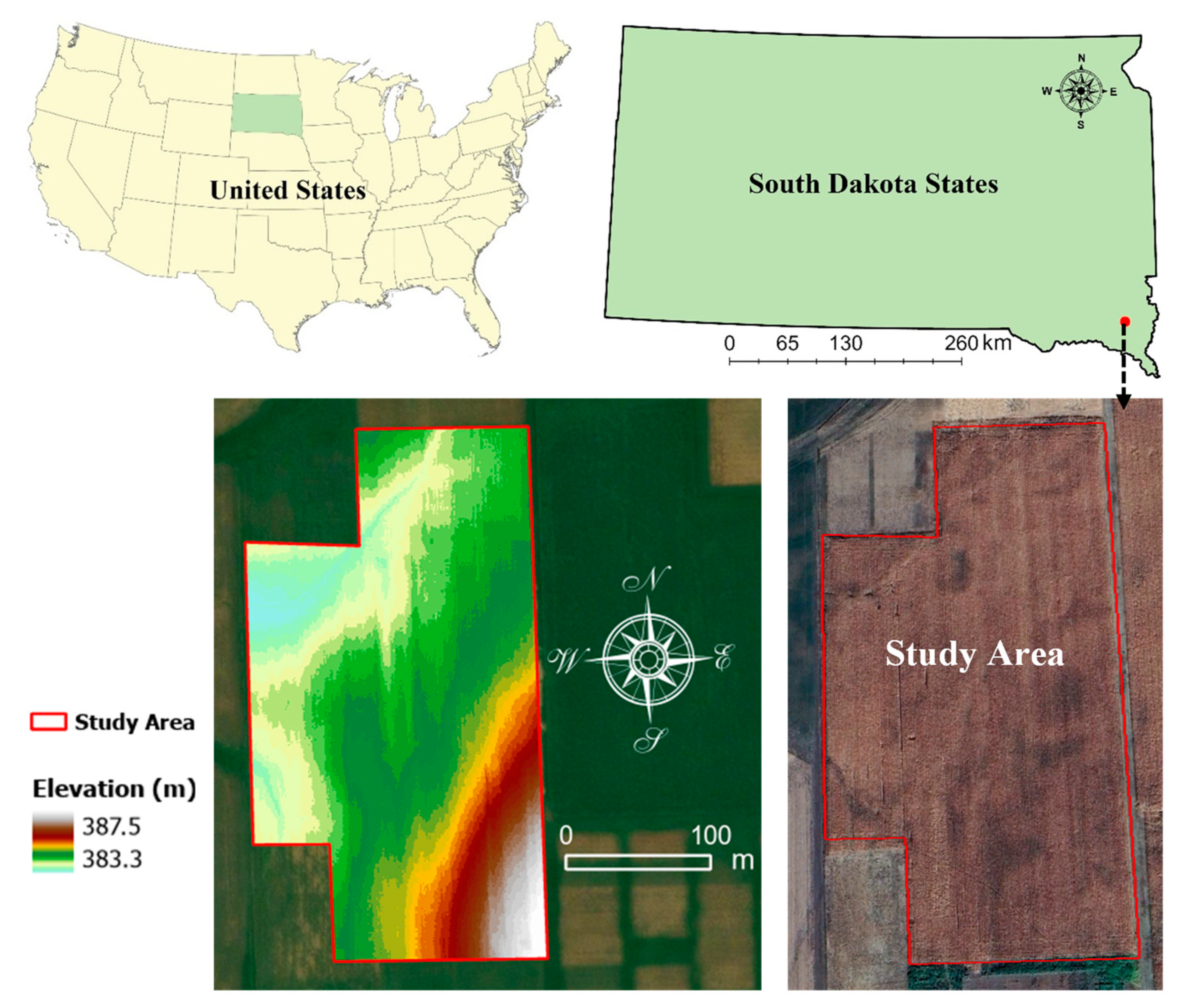


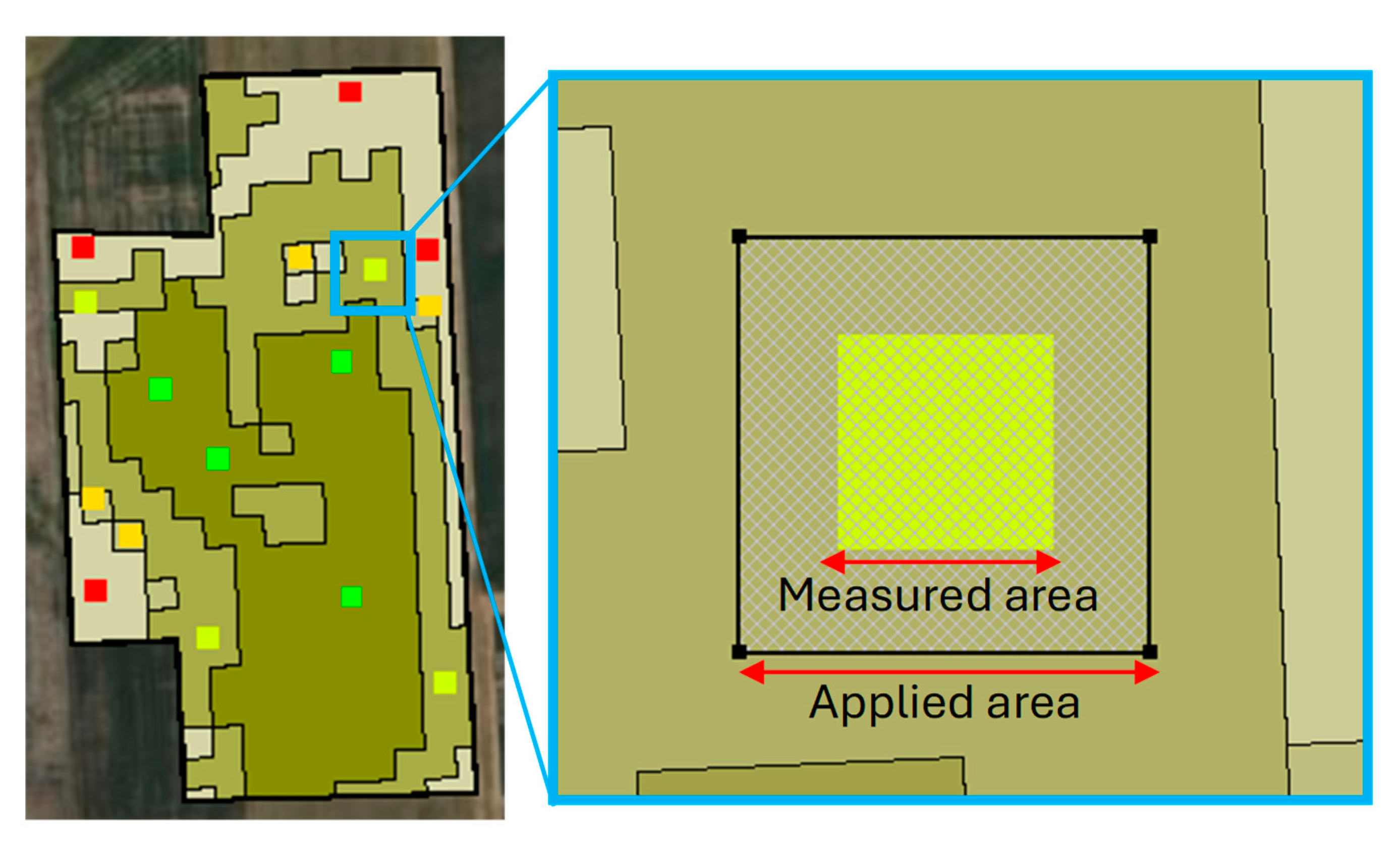

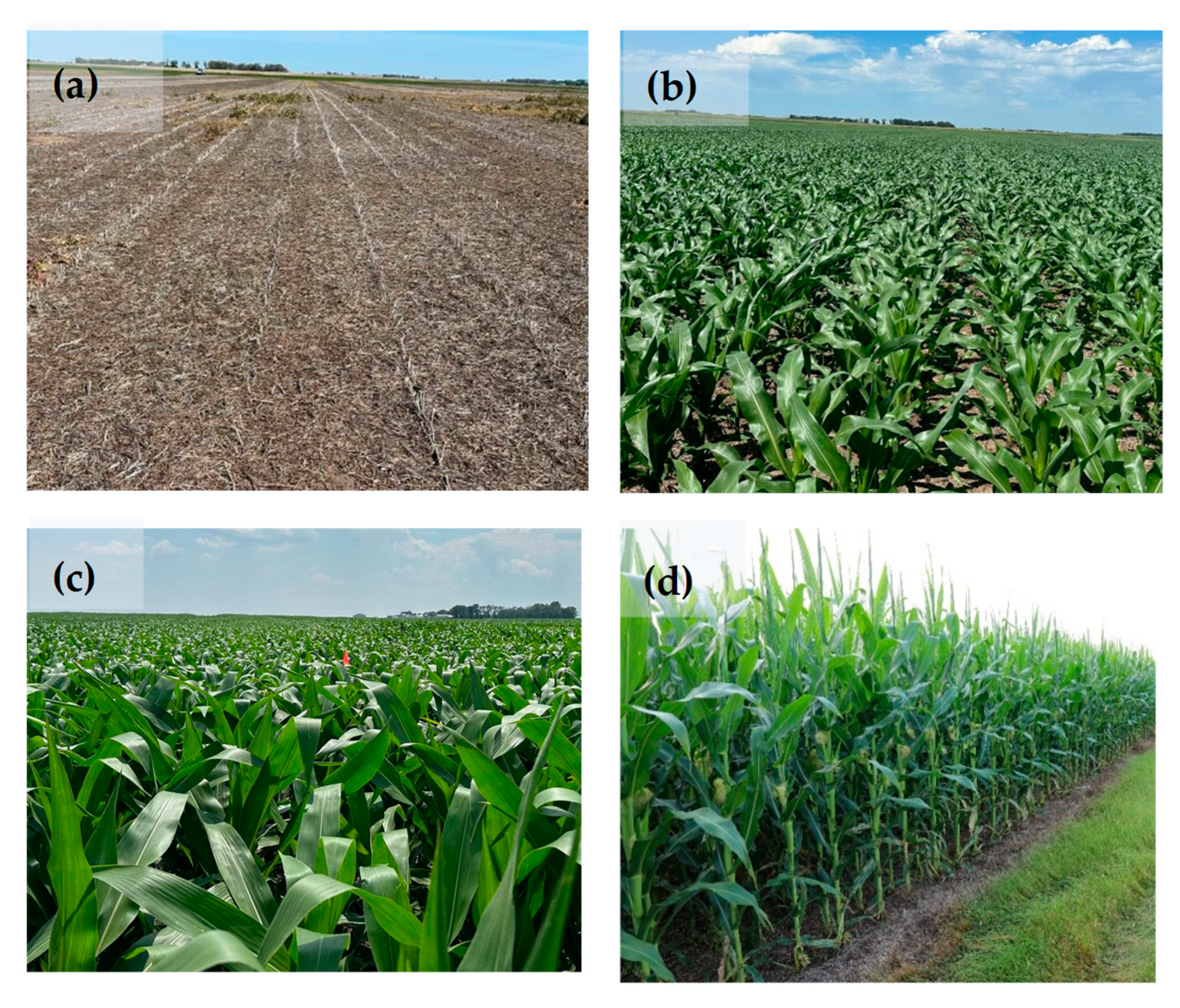

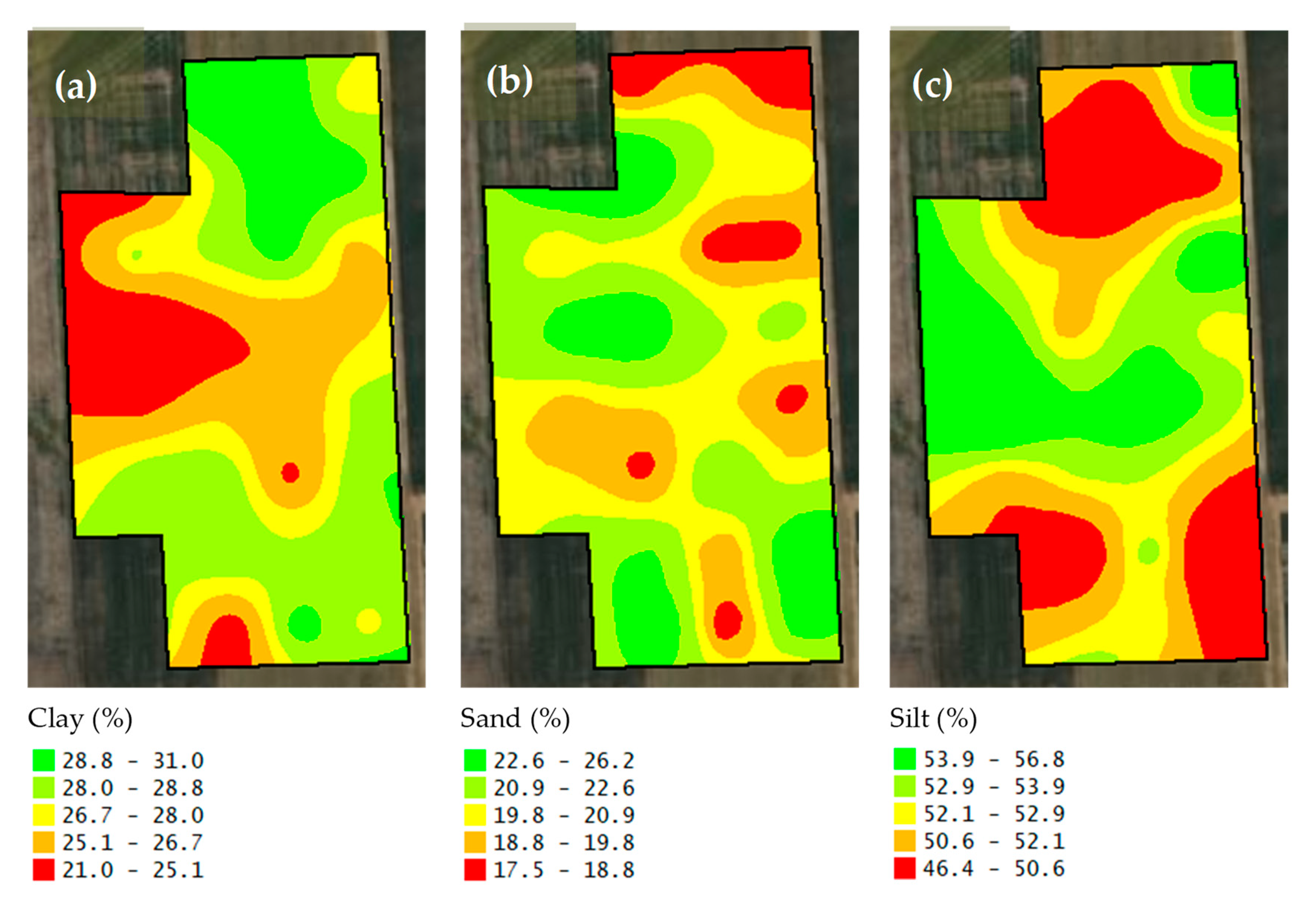
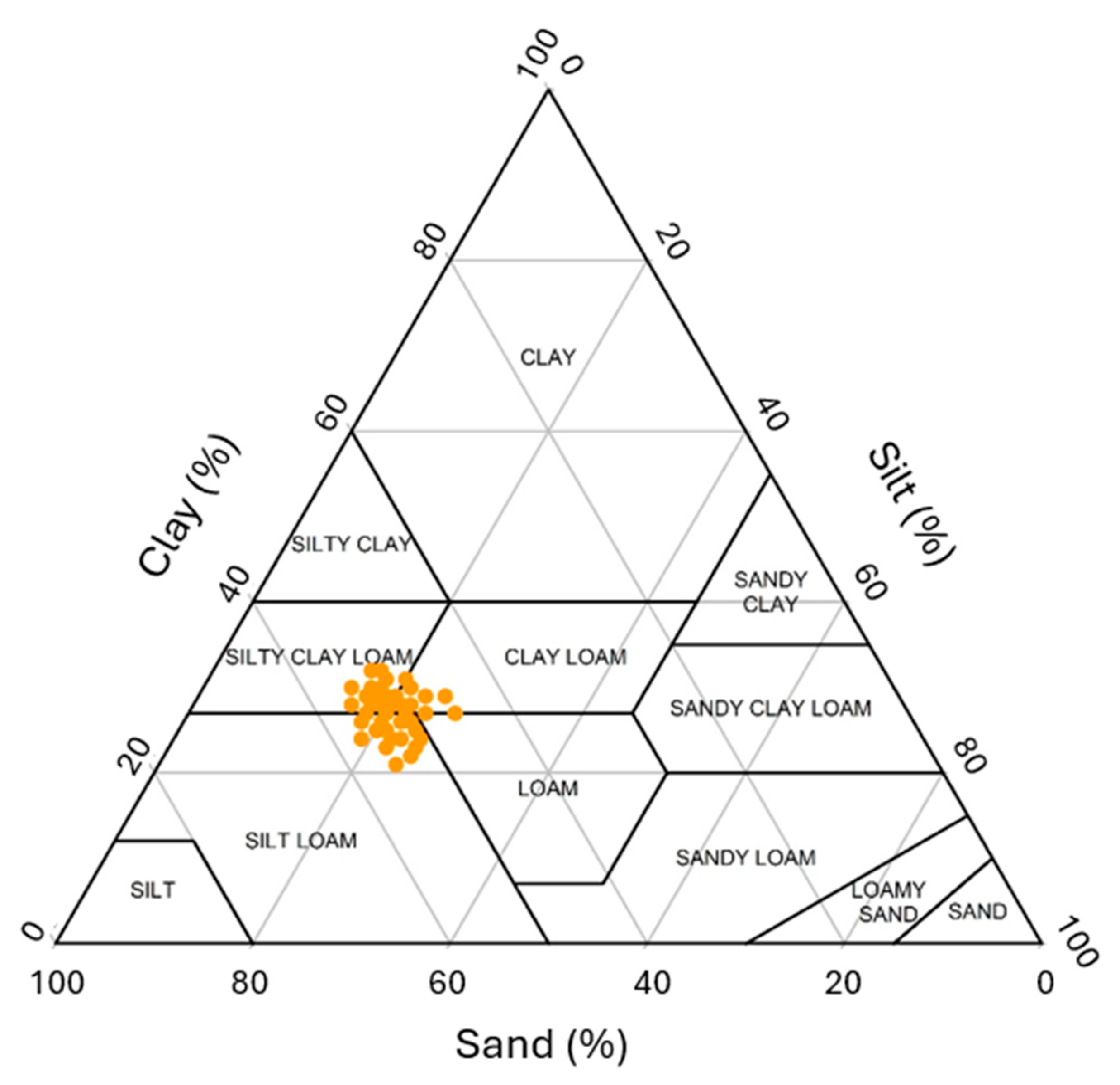
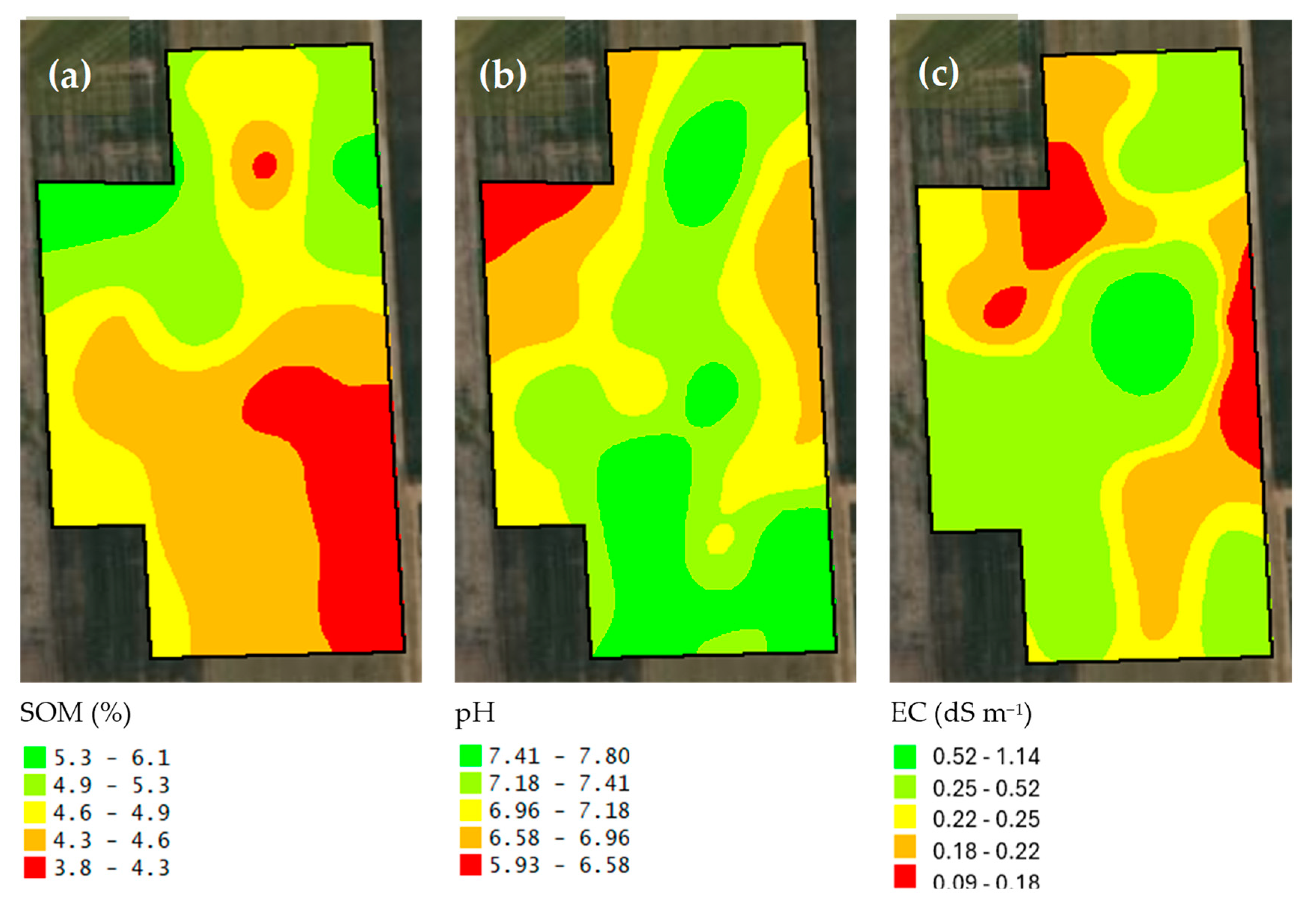

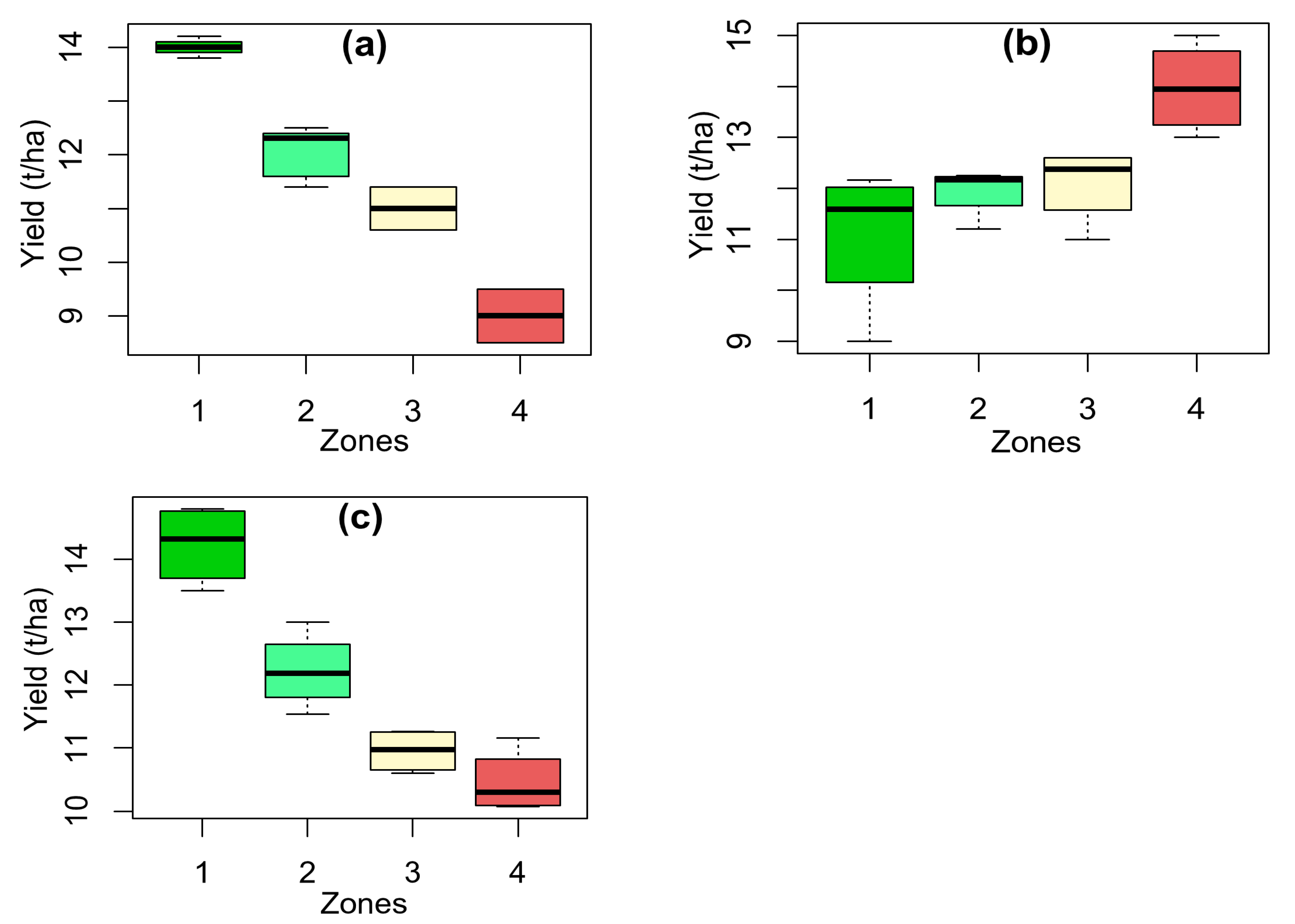



| Soil Features | Min | Max | Mean | Median | Standard Deviation | CV (%) * |
|---|---|---|---|---|---|---|
| Clay (%) | 21.0 | 32.0 | 27.4 | 28.0 | 2.6 | 9.4 |
| Sand (%) | 15.0 | 27.0 | 20.4 | 20.0 | 2.9 | 14.2 |
| Silt (%) | 46.0 | 57.0 | 52.2 | 52.0 | 2.4 | 4.5 |
| SOM (%) | 3.8 | 6.2 | 4.6 | 4.5 | 0.4 | 9.3 |
| EC (dS m−1) | 0.13 | 1.29 | 0.28 | 0.26 | 0.16 | 58.12 |
| pH | 5.9 | 7.9 | 7.2 | 7.2 | 0.4 | 5.7 |
| Nitrogen (kg ha−1) | 9.0 | 50.4 | 25.0 | 22.4 | 10.6 | 47.5 |
| Phosphorus (ppm) | 3.0 | 79.0 | 26.8 | 22.0 | 16.2 | 60.4 |
| Potassium (ppm) | 194.0 | 560.0 | 283.5 | 272.0 | 71.4 | 25.2 |
| Nitrogen Application Method | Zone 1 | Zone 2 | Zone 3 | Zone 4 |
|---|---|---|---|---|
| Flat rate | 14.04 a | 12.08 b | 11.00 c | 9.00 d |
| Soil-based sensors (EC sensor map) | 11.08 b | 11.94 b | 12.09 b | 13.97 a |
| Remote sensing-based method (NDVI map) | 14.23 a | 12.22 b | 10.95 c | 10.45 c |
| Nitrogen Application Method | Zone 1 | Zone 2 | Zone 3 | Zone 4 |
|---|---|---|---|---|
| Flat rate | 0.721 a | 0.619 b | 0.564 c | 0.486 d |
| Soil-based sensors (EC sensor map) | 0.656 c | 0.907 c | 1.137 a | 1.216 b |
| Remote sensing-based method (NDVI map) | 0.737 c | 0.800 b | 0.731 c | 0.885 a |
| Parameters | Nitrogen Application Method | Zone 1 | Zone 2 | Zone 3 | Zone 4 |
|---|---|---|---|---|---|
| Corn Yield | Flat rate | 14.04 a | 12.08 b | 11.00 c | 9.00 d |
| Remote sensing-based method (NDVI map) | 14.23 a | 12.22 b | 10.95 c | 10.45 c | |
| NUE | Flat rate | 0.721 c | 0.619 d | 0.564 e | 0.486 f |
| Remote sensing-based method (NDVI map) | 0.737 c | 0.800 b | 0.731 c | 0.885 a |
Disclaimer/Publisher’s Note: The statements, opinions and data contained in all publications are solely those of the individual author(s) and contributor(s) and not of MDPI and/or the editor(s). MDPI and/or the editor(s) disclaim responsibility for any injury to people or property resulting from any ideas, methods, instructions or products referred to in the content. |
© 2025 by the authors. Licensee MDPI, Basel, Switzerland. This article is an open access article distributed under the terms and conditions of the Creative Commons Attribution (CC BY) license (https://creativecommons.org/licenses/by/4.0/).
Share and Cite
Mirzaee, S.; Mirzakhani Nafchi, A. Enhancing NUE in Corn Through Optimized Sensor-Based Prescription Maps. Sensors 2025, 25, 3148. https://doi.org/10.3390/s25103148
Mirzaee S, Mirzakhani Nafchi A. Enhancing NUE in Corn Through Optimized Sensor-Based Prescription Maps. Sensors. 2025; 25(10):3148. https://doi.org/10.3390/s25103148
Chicago/Turabian StyleMirzaee, Salman, and Ali Mirzakhani Nafchi. 2025. "Enhancing NUE in Corn Through Optimized Sensor-Based Prescription Maps" Sensors 25, no. 10: 3148. https://doi.org/10.3390/s25103148
APA StyleMirzaee, S., & Mirzakhani Nafchi, A. (2025). Enhancing NUE in Corn Through Optimized Sensor-Based Prescription Maps. Sensors, 25(10), 3148. https://doi.org/10.3390/s25103148





